 Get premium membership
Get premium membership and access revision papers with marking schemes, video lessons and live classes.
Form 2 Chemistry End of Term 2 Examination 2022
Class: Form 2
Subject: Chemistry
Level: High School
Exam Category: Form 2 End Term 2 Exams
Document Type: Pdf
Views: 1036
Downloads: 49
Exam Summary
1. Draw a diagram of the apparatus used to measure accurately 250 cm3 of liquids or solutions.
2. In the laboratory, there are two types of flames; with reasons, state which flame is used for:
(a) Heating……………………………………………………………………………………………………………………………………………………………………………(1 mark)
(b) Lighting……………………………………………………………………………………………………………………………………………………………………………(1 mark)
3. Define the term drug abuse. (1 mark)
………………………………………………………………………………………………………………………………………………………………………………………………………………………………
4. Shanty accidentally mixed iron fillings, iron (III) chloride crystals and sulphur powder. Describe how she would obtain each of the substances separately. (3 marks)
……………………………………………………………………………………………………………………………………………………………………………………………………………………………………………………………………………………………………………………………………………………………………………………………………………………………………………………………….
5. Classify the following as either chemical or physical changes. (5 marks)

6. Matter exists in three states. Describe how particles behave in each state according to kinetic theory of matter.
(a) Solid state: (2 marks)
……………………………………………………………………………………………………………………………………………………………………………………………………………………………….
(b) Liquid state: (2 marks)
……………………………………………………………………………………………………………………………………………………………………………………………………………………………….
(c) Gaseous state: (2 marks)
………………………………………………………………………………………………………………………………………………………………………………………………………………………………
7. Explain how acid rain can be formed. (2 marks)
………………………………………………………………………………………………………………………………………………………………………………………………………………………………
8. Solutions may be classified as strongly basic, weakly basic, neutral, weakly acid, or strongly acidic. The information below gives solutions and their pH values. Study it and answer the questions that follow.
Classify the solutions in the table using the stated classifications. (2 Marks)

9. A farmer tested soil in his farm and found out that its pH was 5.5. This was below the recommended pH of 7.0. Suggest how the farmer could achieve the recommended pH of soil in his fam. (1 mark)
………………………………………………………………………………………………………………..
10. Name three gaseous components of unpolluted air. (3 marks)
………………………………………………………………………………………………………………………………………………………………………………………………………………………………………………………………………………………………………………………………………………
11. (a) Zinc reacts with dilute sulphuric (VI) acid to produce a colourless gas. Write an equation for the reaction. (1 mark)
………………………………………………………………………………………………………………..
(b) Describe a test for the colourless gas. (2 marks) ………………………………………………………………………………………………………………………………………………………………………………………………………………………………………………………………………………………………………………………………………………
12. The set – up below was used to obtain a sample of iron metal.
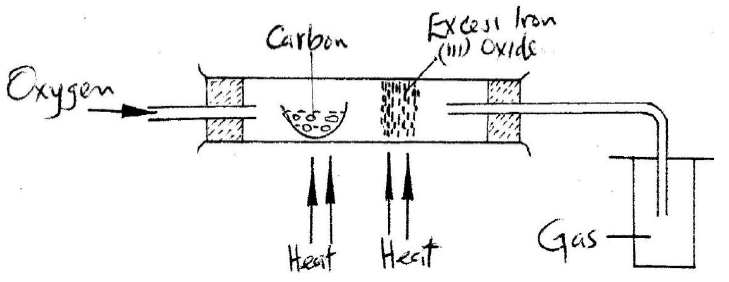
(a) Write two equations for the reactions which occur in the combustion tube. (2 marks)
Equation 1: .........................................................................................................................................................Equation 2: .........................................................................................................................................................
(b) Name the gas collected in the gas jar. ...……………………………………(1 mark)
(c) Give two uses of carbon (II) oxide that are also uses of hydrogen. (2 marks)
……………………………………………………………………………………………………………………………………………………………………………………………………………………………….
13. (a) Name one natural source of water for a chemical industry. (1 mark)
………………………………………………………………………………………………………………..
(b) Kerosene is a hydrocarbon. Name the product of burning kerosene that is a liquid at room temperature. …………………………………………………………………… (1 mark)
(c) Metal Y can displace metal X from its oxide. Hydrogen can reduce the oxide of metal X. Metal X does not react with water, while metal Y reacts with water moderately. Metal
Z reacts with explosively with water. Arrange the metals and hydrogen from the most reactive. (1 mark) ………………………………………………………………………………………………………………
14. The set-up below was used to prepare a gas Q.
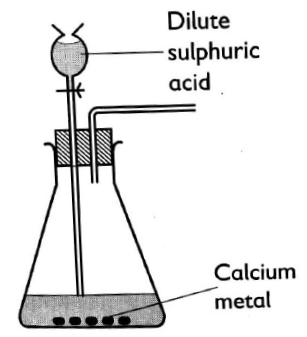
(a) Complete the diagram to show how a dry sample of gas Q may be collected. (2 marks)
(b) Give a reason why calcium is not the most appropriate metal for use in this preparation. (1 mark)
………………………………………………………………………………………………………………
(c) Write an equation for the reaction for the formation of gas Q. (1 mark)
………………………………………………………………………………………………………………..
15. Complete the key shown below for sub atomic particles. (3 marks)
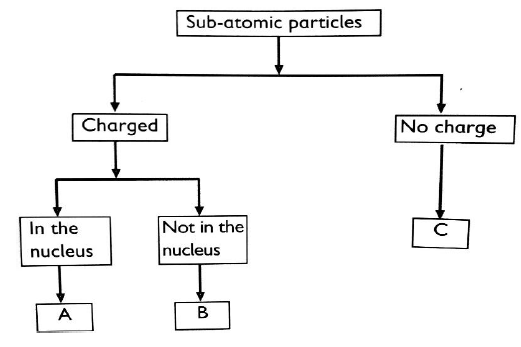
16. The relative atomic mass of element Y which consists of the isotopes 20Y and 22Y is 20.2. Calculate the percentage of the atoms in the isotopic mixture. (3 marks)
17. The ionic radii of the ions of Q and Rare given as follows: Q2+ = 2,8,8 and R- = 2,8.
(a) Complete the table below: (2 marks)

(b) Write the formula of the product formed when Q and R react. (1 mark)
……………………………………………………………………………………………………………
18. The halogens are a group of non-metals in Group VII of the Periodic Table.
(a) Describe an experiment which shows that chlorine is more reactive than iodine. Include a chemical equation in your answer. (3 marks)
………………………………………………………………………………………………………………………………………………………………………………………………………………………………
(b) State two observations made when warm sodium metal in a deflagrating spoon is lowered in a gas jar full of chlorine gas? (2 marks)
………………………………………………………………………………………………………………………………………………………………………………………………………………………………
(c) Write an equation for the reaction in (b) above. (1 mark)
………………………………………………………………………………………………………………
19. The following table gives the number of protons in the nucleus of some elements. The letters do not represent the actual symbols of elements. Use it to answer the questions that follow.

(a) Which elements belong to the same group of the periodic table? (2 marks)
………………………………………………………………………………………………………………
(b) How will the reactivity of element F compare with that of element E? Explain. (2 marks)
………………………………………………………………………………………………………………………………………………………………………………………………………………………………
20. The atomic numbers of elements X and W are 11 and 16 respectively.
(a) Write the electronic arrangements of the elements. (1 mark)
Element X…………………………………… Element W…………………………………
(b) Predict the type of bonding in the product formed if elements W and X were to be reacted. Give the formula of the resulting compound. (2 marks)
Type of bond…………………………………… Formula of compound ………………………
21. The table below show the physical properties of some substances. Use it to answer the questions that follow.
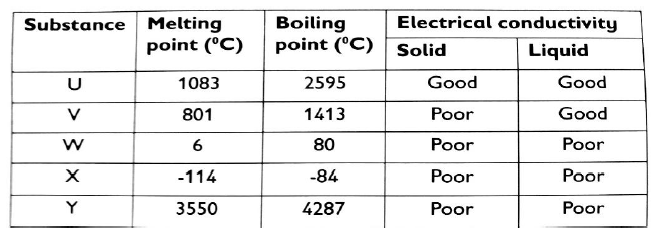
(a) Which substance is likely to be; (1 mark)
(i) A metal? …………………………… (ii) A liquid at 22oC? ………………………….
(b) Which substance is likely to have the following structures? (3marks)
(i) Simple molecular structure …………………………………………………………….
(ii) Giant ionic structure ………………………………………………………………………
(iii) Giant atomic structure ……………………………………………………………………
22. The diagram below shows the apparatus used for the electrolysis of molten sodium bromide.
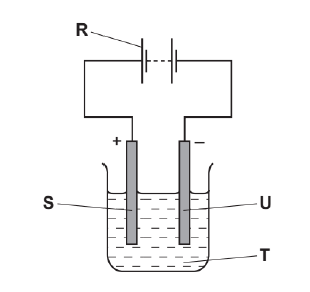
(a) What does the term electrolysis mean? (1 mark)
……………………………………………………………………………………………………………………………………………………………………………………………………………………………….
(b) Which letter R, S, T or U on the diagram represents the cathode? (1 mark)
………………………………………………………………………………………………………………..
(c) State the observation made at the anode. (1 mark)
………………………………………………………………………………………………………………..
(d) Which condition is missing in the set-up? …………………………………… (1 mark)
(e) Write the half equation for the reaction at: (2 marks)
(i) Cathode: …………………………………………………………………………………….
(ii) Anode: ……………………………………………………………………………………….
23. Name the instrument that is used to accurately determine the relative atomic masses of elements. (1 mark)
………………………………………………………………………………………………………………
24. Sketch a heating curve to illustrate the heating curve of pure water from 20oC to boiling.
(1 mark)
25. Name the type of bond and structure of each of the following: (2 marks)
(a) Aluminium
………………………………………………………………………………………………………………
(b) Silicon
………………………………………………………………………………………………………………
(c) Chlorine
………………………………………………………………………………………………………………
(d) Diamond
………………………………………………………………………………………………………………
26. Using iodine molecule, illustrate the difference between covalent bonds and weak Van der Waals forces of attraction. (2 marks)
27. Use dot (.) and cross (x) to show bonding in tetrachloromethane (carbon tetrachloride) CCl4 (2marks)
More Examination Papers